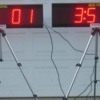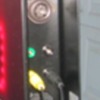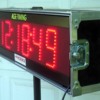PST has recently received a set of ALGE D-LINE LED displays. Regrettably the order that we had earlier in the year failed to arrive. The two displays were lost or stolen enroute.
The D-LINE cabinet is quite a bit smaller that the standard GAZ4. 37.5 inches long x 10 inches tall x 2.25 inches thick. Each box weighs 16 pounds.
They have tabs for hanging from the wall or two types of tripod socket threads. The 3/8 inch socket for a Bogen 3001 tripod. Also, there is two 10mm threads to accept an Ultimate support (BOSE) tripod head.
The power supply accepts 85>240 volts ac. The standard ALGE 4 pole amphenol connector allows the input of 12vdc.
Power consumption appears to be quite reasonable.
They are not as easily viewed in direct sunlight as a GAZ4. Obviously they will be great at night.
Attachments
Original Post



